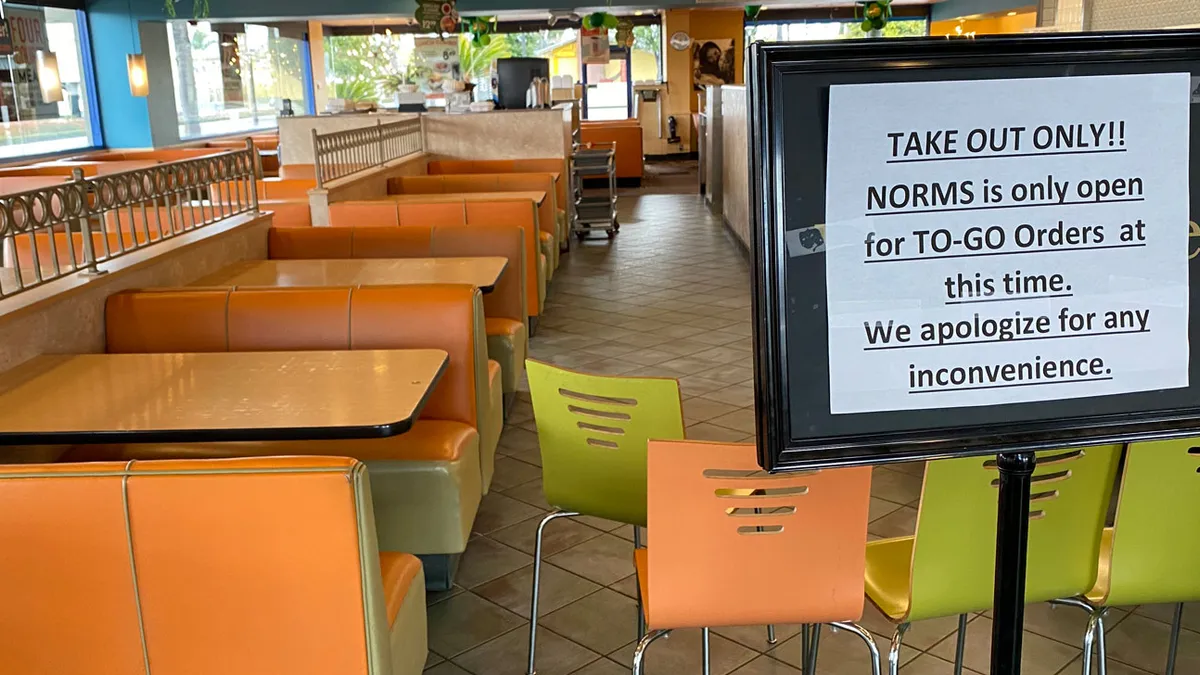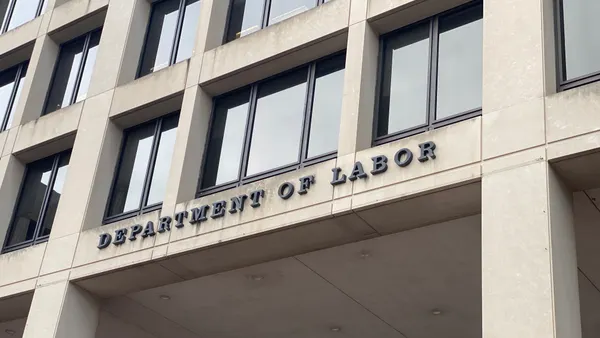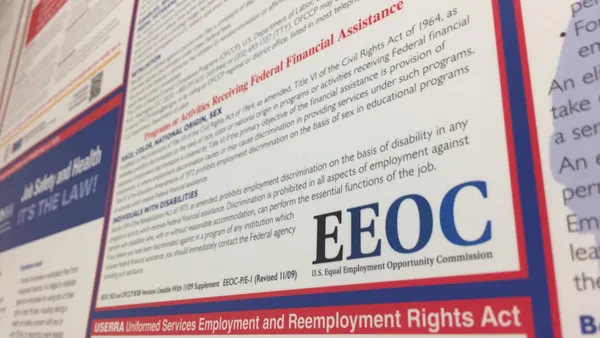UPDATE: April 9, 2020: The U.S. Department of Labor will make technical corrections to the regulations April 10.
Dive Brief:
- The U.S. Department of Labor (DOL) released a temporary rulemaking April 1 implementing the Families First Coronavirus Response Act (FCCRA). The rule is effective through Dec. 31, the agency said.
- Among other things, the regulations make clear that an employee may elect to use — or an employer may require that an employee use — leave such as vacation or personal leave concurrently with expanded family and medical leave. The rules also outline notice requirements and make clear that employers are required to retain all documentation of FFCRA emergency paid leave requests for four years, regardless of whether leave is granted or denied. Employers seeking an exemption from the law will need to sufficiently demonstrate, through documentation, the burden on their business and show that they are exempt, DOL said.
- Additionally, to resolve inconsistencies between the FFCRA's paid sick time and expanded Family and Medical Leave Act (FMLA) provisions, DOL said it would set the unpaid period for emergency FMLA leave at two weeks, rather than 10 days. "As a practical matter, the unpaid period for employees who work regular Monday-through-Friday schedules would still be ten days because that is the number of days they would work in two weeks," DOL said.
Dive Insight:
The rule provides much-needed clarity around the FFCRA — the first-ever federal paid leave law to affect private-sector workers in U.S. history — at a critical time for small businesses and their workers. There are several sections in the rule for both parties to note.
First, the FFCRA's paid sick time (the payout for which depends on how an employee uses it) may not be taken to care for a person with whom an employee does not have a personal relationship, DOL said. The person must be an immediate family member, roommate or a similar person with whom the employee has a relationship that creates an expectation that the employee would care for the person if he or she self-quarantined or was quarantined. That individual must also be (a) subject to a state, federal or local quarantine or isolation order; or (b) advised by a healthcare provider to self-quarantine on a belief that he or she has COVID-19, may have COVID-19 or is particularly vulnerable to COVID-19.
It is established that the law's emergency FMLA paid leave may only be taken if an employee is unable to work or telework due to a need to care for a child under 18 years of age because that child's school or place of care has closed or the child's child care provider is unavailable due to the effects of COVID-19. DOL in its regulations further defined "telework" as "no less work than if it were performed at an employer's worksite." Employees teleworking for COVID-19 related reasons must record and be compensated for all hours actually worked, including overtime, DOL said. But an employer is not required to compensate employees for unreported, COVID-19 related telework, unless the employer knew or should have known about such telework.
An employee subject to a "quarantine or isolation" — which includes a broad range of government orders such as shelter in place, stay at home, quarantine or other such order that restricts citizens' mobility — may not take paid sick leave when the employer does not have work for the employee. "This is because the employee would be unable to work even if he or she were not required to comply with the quarantine or isolation order," DOL said. Such an employee may be eligible for state unemployment insurance, the agency noted.
The above also applies to employees with respect to the emergency FMLA leave. If an employer does not have work for the eligible employee, the employee may not take emergency FMLA leave, DOL said.
In addition to the exemption for certain employers with fewer than 50 employees, DOL further defined the scope of the exemption for certain healthcare providers and emergency providers from the FFCRA's provision. The agency said it would adopt one of two separate definitions of the term "health care provider" for the following purposes:
-
For the "limited purpose" of identifying employees who an employer may exclude from both buckets of the FFCRA's paid leave, DOL will adopt a "broader" definition of healthcare provider that includes any individual capable of providing services necessary to combat COVID-19. This includes medical professionals; those responsible for keeping healthcare facilities supplied and operational; and workers involved in the research, development and production of equipment, drugs, vaccines and similar items needed to combat the disease.
-
For other purposes of FFCRA, such as identifying healthcare providers who may advise an employee to self-quarantine for COVID-19 related reasons, a more narrow definition of the term will be used. This includes "medical professionals who are capable of diagnosing serious health conditions in light of the FMLA's requirement for such healthcare providers to issue certifications regarding the nature and probable duration of serious health conditions."
The regulations also state that employees cannot use paid sick leave or expanded FMLA leave retroactively. In other words, employees need not be paid for unpaid or partially paid leave taken before April 1. Moreover, employers that voluntarily provided paid leave prior to April 1 must still provide the entirety of the FFCRA paid sick leave and emergency FMLA leave to which employees are entitled, regardless of whether such employees took additional paid leave voluntarily offered by the employer, the rule states.
Employers that fail to provide the FFCRA's paid sick time violate the Fair Labor Standards Act's minimum wage mandate, DOL said. Additionally, the FMLA's general prohibitions on interference with rights and discrimination, as well as the law's enforcement provisions, apply to the emergency expansion.
Still, it may be that the FFCRA's implementation has arrived too late for a substantial number of employees. An April 2 DOL news release showed more than 6.6 million initial unemployment claims for the week ending March 28, an increase of over 3 million such claims from the previous week.














